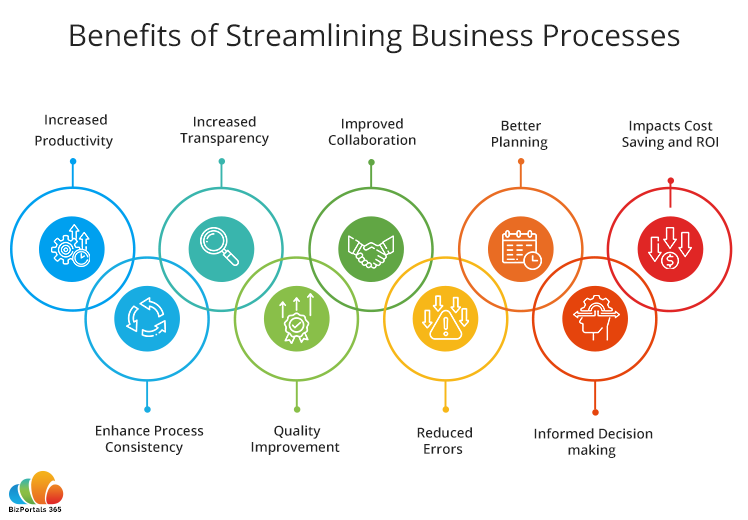The never-ending quest for ways to maximize workplace productivity and operational efficiency has urged modern leaders to step back and optimize their day-to-day operations using contemporary technology. Undoubtedly, the concept of “streamlined workflow” has gained significant traction, becoming a go-to remedy for enterprises striving to maximize operational effectiveness.
So, what exactly is streamlining? Streamlining business processes simply refers to optimizing workflow to eliminate unnecessary or redundant tasks, boosting productivity and operational efficiency of the organization.
Think about the redundant processes your employees perform daily. For instance, getting a project budget approved manually is part of the standard document management workflow performed in organizational settings. However, doing it manually can be time-consuming, specifically if you are not working in a collaborative environment. From submitting a proposal to resubmitting it in case of rejection, it undergoes several stages of estimation and evaluation. However, analyzing the current workflow, breaking down the process, and automating it can be transformational.
This blog offers an in-depth exploration of business processes, workflow, streamlining and its benefits, best practices, and how an intranet can help you streamline processes to achieve operational excellence.
Read to explore:
- Understanding business processes and workflows
- What is streamlining in business? Are intranets the secret ingredient to streamlining business processes?
- Benefits of streamlined processes and workflows
- Examples of streamlining business processes with a robust intranet
- Effective ways to streamline business processes and workflows
- BizPortals 365 intranet: Streamlining business processes to achieve operational excellence
Understanding business processes and workflows
There are many organizations that work in the same domain with similar objectives. The healthcare sector, for example, has many companies working to achieve the same objective of providing quality healthcare and improving patient satisfaction. Nevertheless, the only difference is the business process and workflow they choose to achieve their end goal.
Is there a way to define a business process? So, the term process refers to the sequence of tasks and activities initiated to achieve a specific goal, whereas workflow signifies the order in which these steps are performed across individuals and departments.
Why is it important to streamline processes and workflows?
Unorganized business processes can lead to scattered information, lack of collaboration, risk of data loss, and inconsistency within the workplace. In a recent study from IDC, it was discovered that companies lose between 20 to 30 percent of their annual revenue due to unorganized processes and workflows.
However, to counter the above fact, a Deloitte report suggests that businesses implementing intelligent automation achieve cost savings between 25% and 40% on average as they streamline business processes for enhanced productivity.Let’s begin with the fundamentals to understand what streamlining means in business and how it works.
What is streamlining in business? Are intranets the secret ingredient to streamlining business processes?
Streamlining in business is the process of simplifying complex, informal, and repetitive workflows, ensuring more productive and optimized business processes. Streamlining helps you execute the given series of tasks in a specific sequence to achieve the preset objective while minimizing possible errors.
Over the past several years, businesses have relentlessly pursued process streamlining to promote efficiency, reduce costs, and deliver targeted outcomes. A lack of technological advancements and disengaged employees have made optimizing redundant business processes highly challenging. However, in terms of streamlining, intranets have emerged as a secret ingredient that has the power to enhance business operations in a significant way.
With a secure and unified platform to work on, the intranet offers a range of features that help you optimize your day-to-day business processes, including operations, support, management, and many more. As a result of its ability to centralize information and integrate with various productivity tools, organizations can collaborate effectively on tasks, projects, and documents and share ideas across departments and geographical barriers.
Benefits of streamlined processes and workflows
The growing market demand for workflow management solutions has grown from $4.8 billion in 2018 to a significant number and is estimated to surpass the $26 billion mark by 2025. This is apparently due to their uncountable benefits, including dealing with repetitive tasks, fostering collaboration, and encouraging a culture of innovation and continuous improvement.

Here are some significant advantages of optimizing standard business processes and workflows while having a robust intranet by your side:
1. Streamlined processes increase employee productivity
An organization’s productivity is inversely proportional to the number of repetitive tasks the employees perform. Certainly, streamlining and automating repetitive tasks helps you divert your employees’ efforts to the tasks that actually add value. Simply put, an intranet promotes improved task management while eliminating unnecessary steps to create a more efficient and agile workplace model.
2. It reduces errors and redundancies and limits manual intervention
More often, standardizing regular tasks improves the workflow by reducing the manual intervention of the employees. Implementing streamlined workflows also helps you get a clear overview of existing processes, thus allowing you to put checks on the vulnerabilities quickly. Easily monitor the process, pinpoint the areas of improvement, identify dependencies, and make effective plans for proactive decision-making.
3. Communicate more effectively within the organization
In an organization, your internal communication strategy determines how employees engage with each other and management. With an intranet in place, mastering both up and down communication channels is effortless, conveying the right information to the right person at the right time. It helps you communicate and collaborate better with your teammates while facilitating 1:1 chats, meetings, and video conferencing using a range of communication tools.
4. Streamlined processes to improve transparency and accountability
Leveraging the robust features of an intranet solution, like a centralized repository, versioning, and co-authoring, helps you streamline your documentation process. It enables you to get all the policy documents, guidelines, and FAQs in one place to help employees comply with specific industry standards. As well as improving transparency, it adds granular permission levels to the information to make it clear which users are authorized to access the data and up to what limit.
Examples of streamlining business processes with a robust intranet
Our discussion so far has shown how optimizing regular tasks can boost efficiency, productivity, and transparency in your workplace. However, it is quite essential to understand the impact of streamlining formal and informal business processes at the granular level within an organization. Indeed, we can list hundreds of processes that can be optimized using an intranet solution. Following are some examples of how streamlining benefits different areas of an organization and how the intranet facilitates these improvements:
1. Streamlining processes makes document management easier
The intranet plays a crucial role in streamlining your organization’s document management. It enables you to easily create, store, manage, and share documents in a centralized and secure repository, impacting the overall document life cycle. However, faster access to critical documents, collaborating on them effectively, and getting them approved quickly are some key benefits of streamlined processes. Adding email notifications or approval reminders for all stakeholders involved in the document approval process also promotes your efforts dedicated towards improved productivity.
2. Empowering HR operations with streamlined workflows
HR operations, from onboarding new employees to managing personnel records, can be effectively streamlined through workflow automation. You can simply standardize form requests, approvers, and validation criteria and automate the notification system for better transparency, clarity, and consistency among different processes. Adding more to it, the intranet also helps HR to get streamlined workflows for policy documents, offering learning resources, promoting employee engagement, and adding self-service features for employees to help them understand their role better in the organization.
3. A seamless way to consolidate project management
Scattered processes likely have an inherent risk of overruns and delays, significantly impacting the project’s progress. On the other hand, the intranet tries to consolidate such processes by digitizing project tasks, priorities, objectives, deadlines, and resources, even in a remote workplace model. You can create dedicated project sites, examine pending or completed action items, and brainstorm together to bring all your team members on the same page.
4. Leverage streamlining to create, manage, and share knowledge
An intranet, well-known as a living document that is constantly updated with relevant information, is the most effective tool for knowledge management. You can leverage a dedicated wiki site, document libraries, and a range of communication tools that support flawless creation and sharing of knowledge among employees. Apart from creating a knowledge base, you can also bring your experts together on a unified platform to promote the constant professional development of your employees.
Effective ways to streamline business processes and workflows
Throughout this course, we have explored the benefits of streamlined processes and how they impact various aspects, such as projects, documents, departments, teams, and employees. Still, organizations need help determining which process is redundant, how to eliminate unnecessary steps, and, most importantly, which process, or workflow needs to be streamlined.

Listed below are some practical ways to streamline business processes in your organization.
1. List down the processes in your organization and mark out the areas of improvement before strategizing your workflow.
2. Make your processes more manageable by breaking them down into simpler ones and try to optimize them until you have the shortest, most accurate workflow.
3. Various steps in the process are interrelated. And each step should be prioritized and ranked based on its importance.
4. Identify the processes that can be automated, such as invoice generation, document approval, application tracking, automated email reminders, etc., and choose a specific workflow.
5. Create a visual representation of the process and set accountability based on the role of the stakeholders involved in the process.
6. Ask your technical experts to deploy workflows that suit your requirements or customize your own workflows.
7. Processes or priorities are subject to change from time to time. Try to test your streamlined processes and workflows at regular intervals and adjust them if required.
8. Encourage your employees to offer feedback on the process they are involved in, since they are familiar with it and may have suggestions for streamlining it more effectively.
BizPortals 365 intranet: Streamlining business processes to achieve operational excellence.
Business processes, or workflows, are usually a set of repeatable steps focused on a particular objective. The greatest advantage of a business process, however, is its ability to be streamlined to reduce redundancy and increase efficiency. On the same lines, BizPortals 365, a SharePoint-based intranet solution, provides contemporary leaders with the platform they need to minimize unnecessary steps, making them competitive and agile.
BizPortals 365 helps you enhance workflow efficiency and automate standard processes by targeting potential improvement areas to build a customized solution that supports all your specific business requirements. Furthermore, SharePoint environments facilitate flawless communication and collaboration, even in a hybrid environment, bringing all stakeholders on the same page.
Get Free Product Tour



